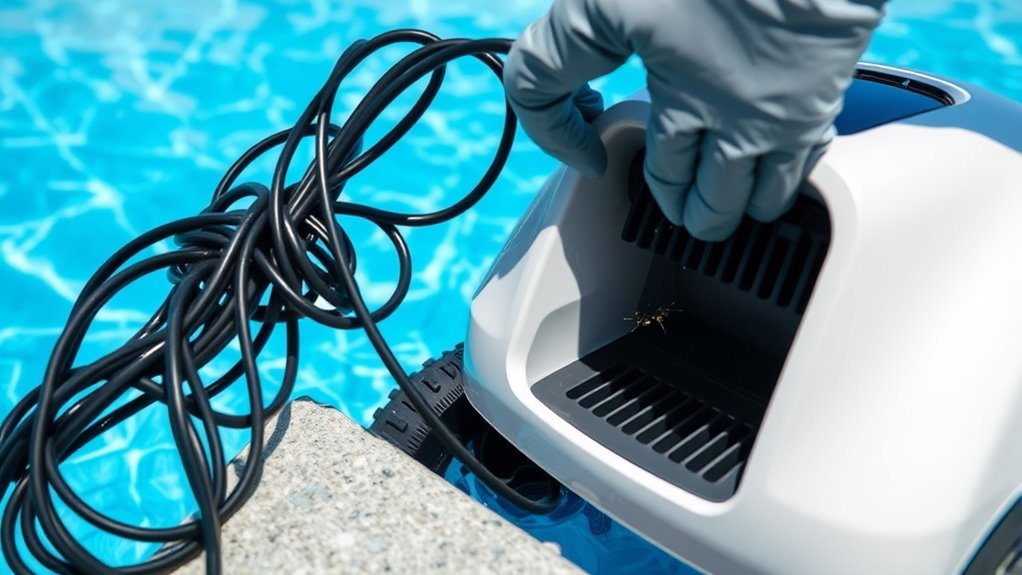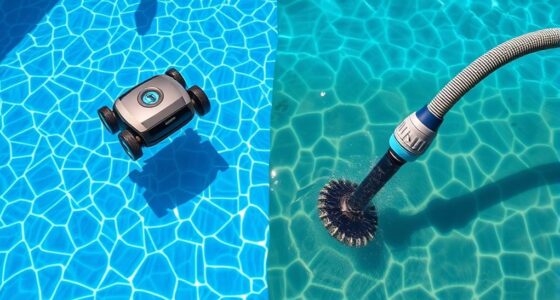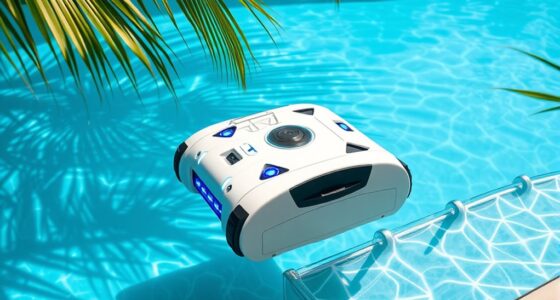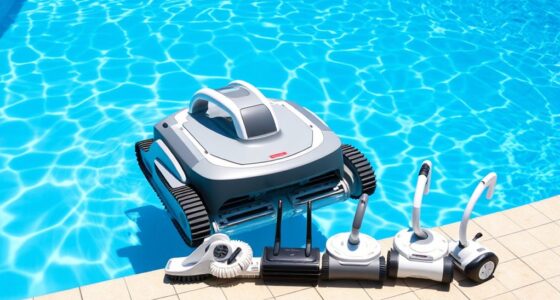If your robotic pool cleaner isn’t working right, start by checking the power supply, cables, and remote connections. Make certain the robot isn’t stuck, has clean filters, and that sensors are free of debris. Look for issues like water leaks or strange noises, and reset or update the software if needed. Troubleshooting common problems often involves basic maintenance, but flagging persistent issues means there are more steps to explore for long-term solutions.
Key Takeaways
- Check power supply, cords, and outlets; perform resets or firmware updates to resolve power and movement issues.
- Inspect and clean filters, brushes, wheels, and sensors to improve cleaning performance and prevent obstructions.
- Ensure the docking station is properly positioned, contacts are clean, and pathways are clear for smooth docking.
- Verify battery health, proper charging practices, and remote connection signals to address battery and connectivity problems.
- Identify and fix leaks or water intrusion by inspecting seals, seals, and housing for damage or debris buildup.
The Robot Isn’t Turning On
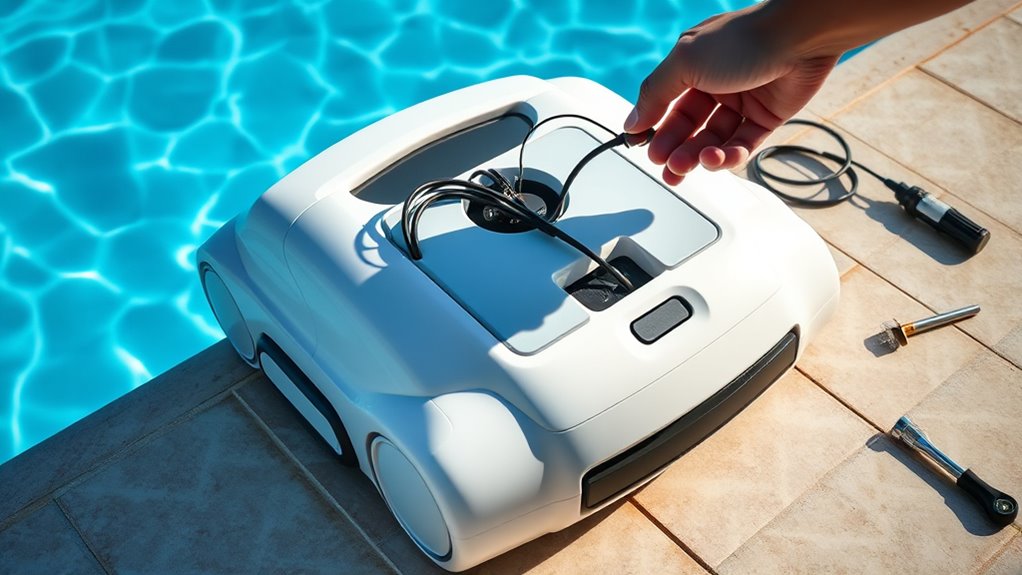
If your robotic pool cleaner isn’t turning on, the first step is to check the power supply. Make sure the outlet is working by plugging in another device. Inspect the power cord for any damage or loose connections. Sometimes, a simple reset can resolve the issue; try performing a factory reset if your device has that option. Refer to your user manual for instructions on how to reset the cleaner, as this can restore default settings and potentially fix power-related problems. Confirm the power supply unit is properly connected and functioning. If the cleaner still doesn’t turn on after these checks, consider testing a different outlet or replacing the power cord. Addressing these basic power supply issues often solves the problem before considering more complex repairs. Additionally, staying informed about AI in Education can provide insights into how automation is transforming industries, including maintenance and troubleshooting processes. For example, AI-driven diagnostics are increasingly used to identify hardware issues more efficiently, which can be beneficial in troubleshooting your robotic pool cleaner. Being aware of smart troubleshooting tools can further streamline the repair process and save time. Moreover, leveraging remote monitoring technologies can help detect and diagnose problems quickly without needing to be physically present. Also, employing predictive maintenance strategies can prevent future issues by addressing potential failures before they occur.
The Cleaner Is Not Moving or Covering the Pool
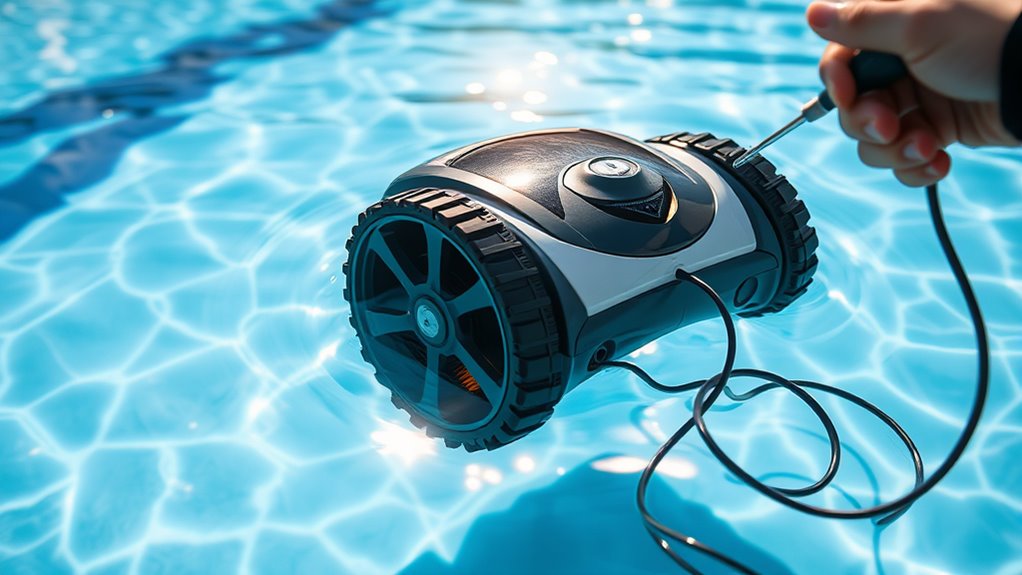
When your robotic pool cleaner isn’t moving or covering the pool as it should, the issue often lies with the navigation system or motor function. Check that the robot’s weight distribution is balanced; uneven weight can hinder movement. Also, ensure the pool water chemistry is within ideal levels, as imbalanced water can cause the robot to stall or behave erratically. Clean any debris or obstructions from the wheels and brushes, which can impede mobility. Verify that the power supply and cables are secure and functioning properly. If the robot still won’t move, reset the system or update its firmware. Proper weight distribution and clean, balanced water are key to guaranteeing your cleaner covers the entire pool effectively. Additionally, maintaining an ergonomic workspace can help you troubleshoot and repair your device more efficiently. Regularly inspecting and maintaining the mechanical components ensures optimal performance and longevity of your robotic cleaner. Incorporating fire safety awareness into your troubleshooting routine can prevent potential hazards during maintenance. Ensuring the electrical connections are properly insulated and protected can also help avoid malfunctions. For optimal performance, consider evaluating the navigation system to rule out faults that could be affecting coverage.
Poor Cleaning Performance or Missed Spots
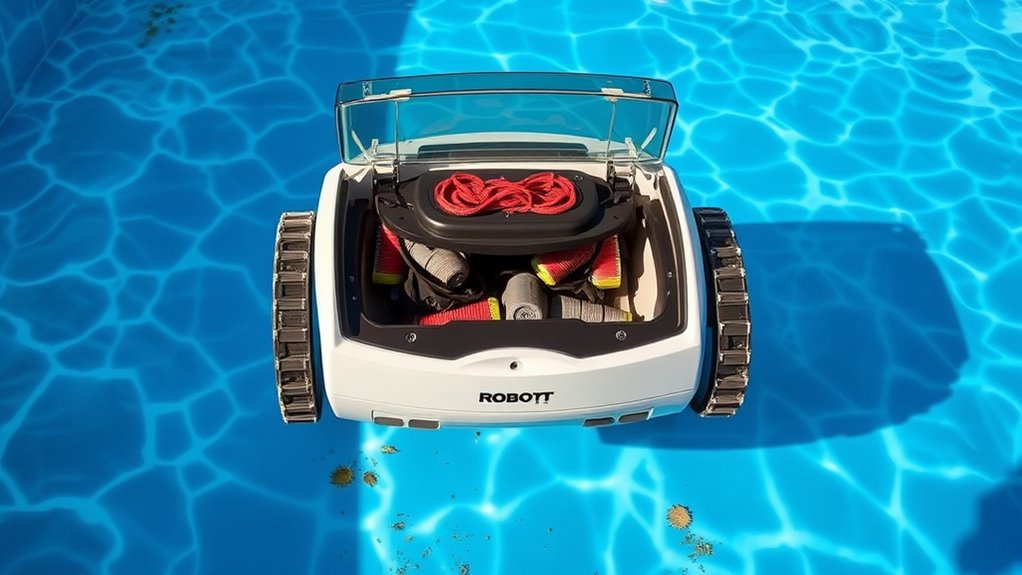
Poor cleaning performance or missed spots often result from obstructions or improper calibration. To fix this, start by checking for debris blocking the cleaner’s path or sensors. Regular filter maintenance is essential—clean or replace filters to guarantee maximum suction and debris collection. Inspect the brushes for wear or damage; worn brushes can reduce cleaning efficiency. Make sure the robot’s calibration aligns with your pool’s shape and size. Additionally, verify that the wheels and tracks are free of debris, allowing smooth movement. Maintaining proper calibration is crucial for optimal performance, especially as some AI-powered robots can learn and adapt their cleaning patterns over time. Ensuring that the self-watering system is functioning correctly can also prevent issues related to moisture levels affecting the robot’s components. Regularly checking the glycolic acid levels in your skincare routine can help maintain the robot’s optimal functioning, as improper levels may impact performance. Furthermore, monitoring the sensor alignment ensures the robot accurately navigates your pool without missing spots. Proper maintenance of navigation systems can significantly enhance cleaning accuracy and efficiency.
The Robot Gets Stuck or Becomes Entrapped
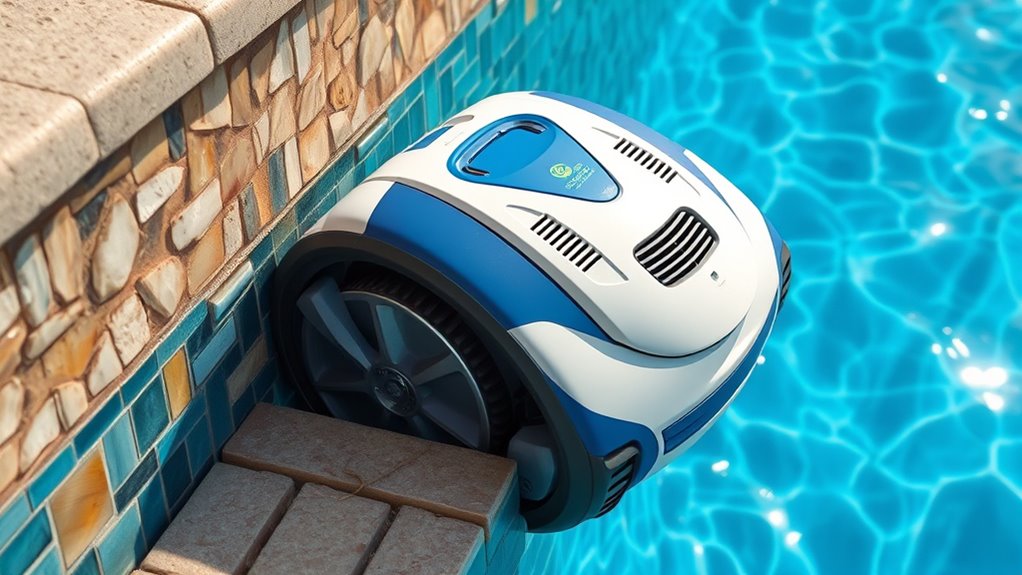
Robotic pool cleaners can get stuck or become entrapped due to obstacles or uneven surfaces in your pool. To prevent this, focus on effective entrapment prevention by regularly removing debris, toys, or other objects that could block the robot’s path. Check for sharp edges, narrow gaps, or areas where the cleaner might get caught, like drain covers or steps. Adjust the robot’s navigation settings if possible, or manually guide it around problematic spots. Ensuring your pool’s surfaces are even and free of loose debris helps minimize the risk of entrapment. Regular obstacle removal and pool maintenance keep your cleaner operating smoothly, reducing downtime and potential damage. Additionally, understanding pool surface types can help you identify areas more prone to getting stuck. Being aware of common causes of entrapment can further assist in troubleshooting and preventing issues before they occur. Regularly inspecting your pool for potential hazards and proper maintenance practices can significantly enhance your robotic cleaner’s performance and lifespan. Taking these steps helps your robotic cleaner work efficiently without getting stuck.
Unusual Noises During Operation
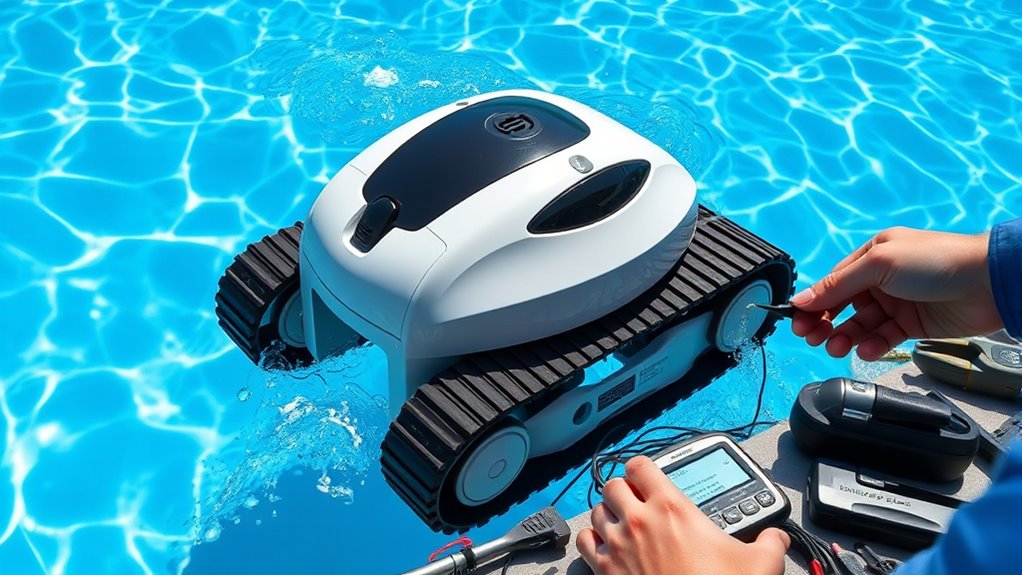
Unusual noises during operation can indicate that your robotic pool cleaner is experiencing a problem. These sounds often signal issues that require immediate attention or robotic maintenance. To properly address noise diagnosis, listen carefully to identify the type of noise—grinding, clicking, or squealing.
- Check for debris: Obstructions can cause grinding sounds and hinder movement. Removing debris helps prevent further mechanical strain and potential damage.
- Inspect the brushes and wheels: Worn or loose parts may produce clicking or squealing noises. Regularly replacing or tightening these components can restore smooth operation.
- Examine the drive motor: Unusual sounds here could mean mechanical issues needing maintenance. Proper lubrication and servicing can extend motor lifespan.
- Ensure proper assembly: Loose screws or parts can generate noise during operation. Double-checking assembly ensures all components are securely in place.
- Regular maintenance and parts replacement can prevent many common issues and reduce unwanted noises. Additionally, consulting the sound science behind vibrations can help diagnose persistent problems more effectively. Understanding vibration analysis techniques can aid in identifying specific mechanical faults and improving troubleshooting accuracy. Implementing regular inspections can also help catch issues early before they become major problems.
The Cleaner Is Not Returning to Its Docking Station
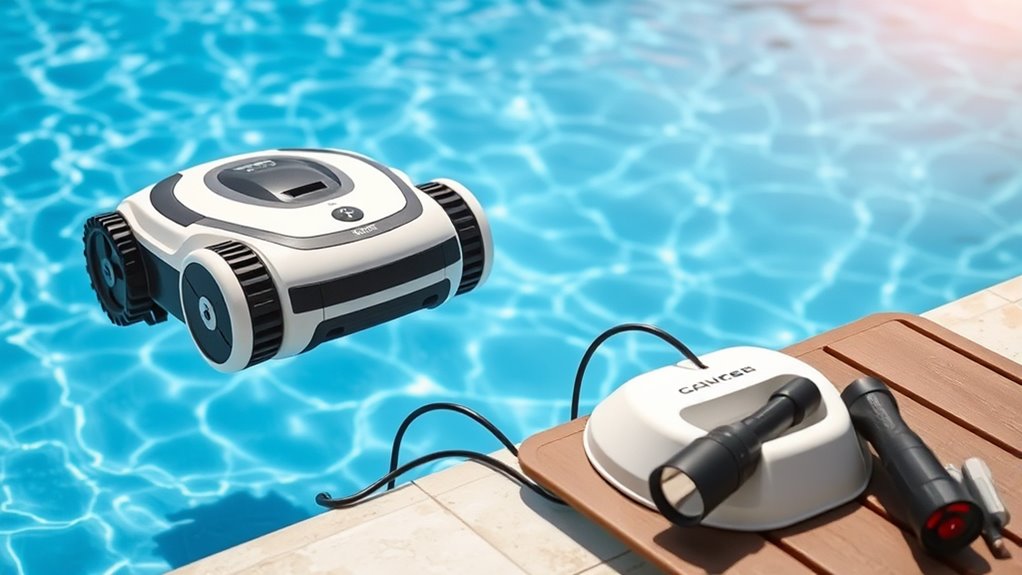
| Issue | Solution |
|---|---|
| Docking station misplaced | Move it to an open, shaded area |
| Obstacles blocking dock | Clear nearby objects |
| Dirty docking contacts | Clean contacts regularly |
| Incorrect robot orientation | Guide the cleaner manually to dock |
| Mechanical issues | Inspect for damage or debris affecting docking |
Address these factors, and you’ll improve your cleaner’s docking success.
Water Leaking or Excessive Moisture Inside the Unit
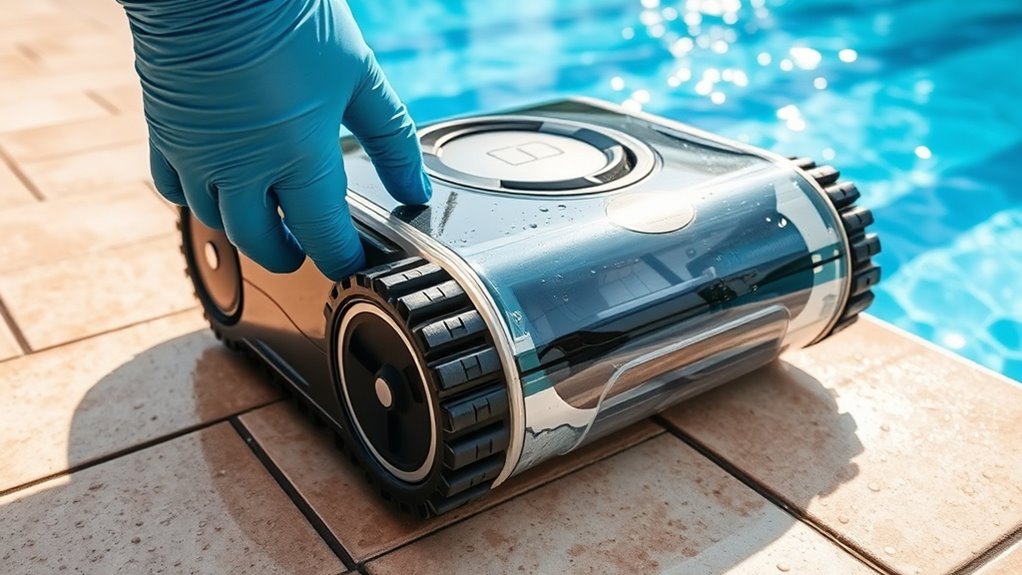
If water leaks or excessive moisture appears inside your pool cleaner, it can indicate a problem with the unit’s seals or internal components. Water intrusion can lead to moisture damage, affecting the cleaner’s performance and longevity. To address this, inspect the seals and housing for cracks or gaps. Moisture inside the unit suggests that water is getting in where it shouldn’t.
- Check and replace worn or damaged seals
- Ensure all compartments are correctly sealed after cleaning
- Look for cracks or holes in the housing
- Remove any debris or blockages that may cause water buildup
Taking these steps helps prevent further water intrusion and protects your cleaner from moisture damage, keeping it running smoothly.
Battery Life Is Short or Drains Quickly

If your robotic pool cleaner’s battery is draining quickly, it might be due to age or performance issues. Make sure you’re following proper charging practices, like charging fully before each use. Addressing these points can help extend your battery life and keep your cleaner running longer.
Battery Age and Performance
A common issue with robotic pool cleaners is their battery life shortening or draining quickly, which can considerably reduce cleaning time and efficiency. As your battery ages, its capacity diminishes, affecting overall battery longevity and power maximization. To improve performance, consider the following:
- Regularly check for signs of battery wear and replace if needed
- Keep the battery contacts clean and free from debris
- Avoid exposing the battery to extreme temperatures
- Use the manufacturer’s recommended charger to guarantee ideal charging cycles
Proper Charging Practices
Wondering why your robotic pool cleaner’s battery drains quickly? Proper charging is key to extending battery life. Make sure you always use the correct charger and avoid overcharging, which can harm battery health. Consistent battery maintenance, like fully charging before use and unplugging once complete, helps preserve capacity. Avoid leaving your cleaner in the sun or in wet conditions while charging. Here’s a quick guide:
| Tip | Explanation |
|---|---|
| Use original charger | Ensures proper charging voltage and current |
| Charge in a dry place | Prevents damage to the battery |
| Don’t overcharge | Stops battery from degrading faster |
| Fully charge regularly | Maintains excellent battery health |
| Store properly | Keeps the battery in good condition for future use |
Following these practices keeps your robotic cleaner running longer and more efficiently.
Connectivity or Remote Control Issues
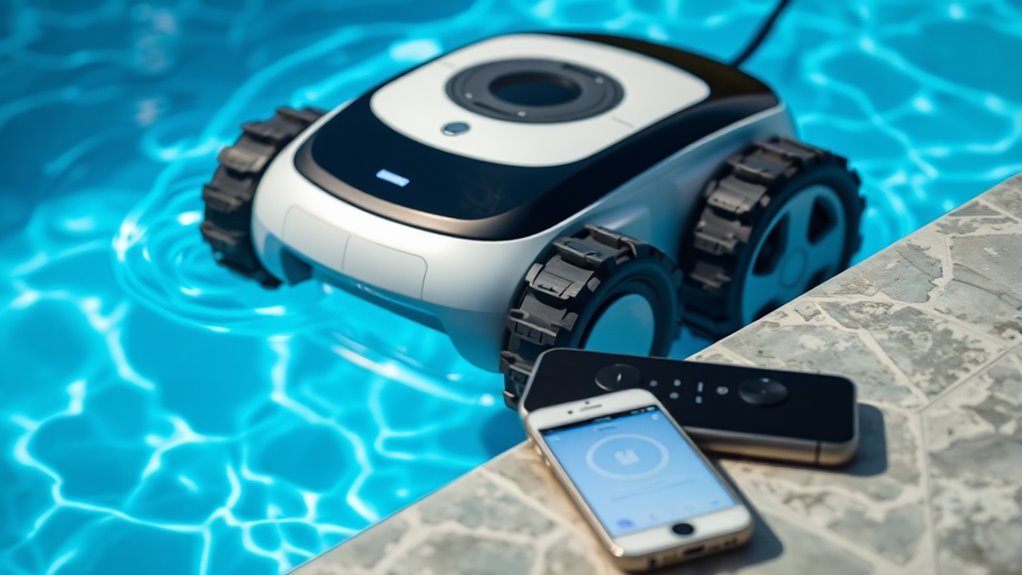
Connectivity problems or remote control issues can be frustrating, but they often stem from simple causes that are easy to fix. If your robotic pool cleaner isn’t responding, start with wireless connectivity checks. Verify you’re within range and that there are no obstructions blocking signals. For remote control troubleshooting, replace batteries and verify that the remote is aimed directly at the device. Also, restart both the cleaner and remote to reset connections.
Check Wi-Fi range, replace remote batteries, and restart devices to fix connectivity and control issues easily.
- Check Wi-Fi signal strength and reconnect if needed
- Keep the remote within the recommended range
- Remove any interference sources, like other electronics
- Update the cleaner’s firmware if available
Addressing these common issues can restore smooth control without hassle.
Error Codes and Indicator Lights

When your pool cleaner shows an error code or a blinking light, it’s a clear sign something’s wrong. You’ll need to recognize what each code or signal means to identify the issue quickly. Let’s go over how to interpret these signals and troubleshoot common problems effectively.
Recognizing Error Codes
How can you tell if your robotic pool cleaner is experiencing a problem? Recognizing error codes is key. When your cleaner encounters an issue, it often displays specific codes or flashing indicator lights. These signals help you identify what’s wrong and plan your robot maintenance accordingly. Familiarizing yourself with these codes saves time and prevents further damage. Make sure your software updates are current, as outdated software can cause miscommunication of errors. Keep an eye out for common signs like sudden stops, poor cleaning, or unusual noises, which may correspond to specific error codes.
- Check the user manual for error code explanations
- Refer to the manufacturer’s app or website for updates
- Reset the cleaner to clear temporary errors
- Schedule regular software updates to avoid false alarms
Interpreting Indicator Lights
Indicator lights on your robotic pool cleaner provide quick, visual clues about its current status and any potential issues. Recognizing these lights helps you perform effective robot maintenance and ensure proper water filtration. For example, a blinking light may signal a clogged filter or water flow problems, while steady lights indicate normal operation. Use this guide to interpret common indicator signals:
| Light Pattern | Meaning |
|---|---|
| Solid green | Fully operational, no issues |
| Blinking yellow | Water filtration or water flow issue |
| Red steady | Error requiring reset or maintenance |
| Blinking red | Critical malfunction, disconnect immediately |
Regularly checking these indicator lights keeps your robot running efficiently and helps troubleshoot issues early.
Troubleshooting Common Signals
Understanding the signals your robotic pool cleaner sends is key to quick and effective troubleshooting. Error codes and indicator lights alert you to specific issues, often related to signal interference or wireless connectivity problems. When signals are weak or inconsistent, your cleaner may stop working or display error messages. Recognizing these signals helps you identify the root cause and resolve it promptly.
- Check for signal interference from other electronic devices near your cleaner.
- Ensure your wireless connectivity is stable—reboot your router if needed.
- Keep the communication path clear of obstacles that could block signals.
- Refer to your cleaner’s manual for specific error code meanings and troubleshooting steps.
Frequently Asked Questions
How Often Should I Clean or Replace the Robot’S Filters?
You should clean your robotic pool cleaner’s filters regularly to maintain ideal performance. Typically, it’s best to check the filter after each use and rinse it with water. For the filter replacement schedule, replace the filters every 6 to 12 months, depending on usage and debris buildup. Consistent filter maintenance ensures your robot runs efficiently, prolongs its lifespan, and keeps your pool sparkling clean.
Can Debris or Algae Clog the Robot’S Brushes or Intake?
You should regularly check for debris or algae buildup that can cause brush blockages or clog the intake. When debris accumulates, it can restrict the robot’s movement and reduce cleaning efficiency. Algae can also stick to brushes, leading to blockages. To prevent issues, clean the brushes and intake area often, especially after heavy algae blooms or debris-filled debris, ensuring your pool robot works smoothly and efficiently.
Is It Normal for the Robot to Emit a Strange Smell?
If your robotic pool cleaner emits a strange odor, it’s understandable to be concerned. Odor concerns often stem from debris or algae trapped inside, which can cause smells over time. Regular filter maintenance helps prevent this by removing buildup that causes odors. Make sure to clean the filter and brushes frequently, as neglecting these parts can lead to unpleasant smells. Proper upkeep keeps your cleaner running smoothly and odor-free.
How Do I Update the Robot’s Firmware or Software?
To update your robotic pool cleaner’s firmware or perform a software upgrade, first check the manufacturer’s app or website for the latest updates. Connect your device via Wi-Fi or Bluetooth, then follow the instructions to download and install the firmware updates. Make sure your device is fully charged and connected to a stable internet connection. Regular updates improve performance, fix bugs, and add new features, keeping your cleaner running smoothly.
What Safety Precautions Should I Follow During Maintenance?
When performing maintenance, you should prioritize electrical safety by unplugging the robot before opening it. Always handle chemicals carefully, avoiding spills or splashes, and wear protective gloves if needed. Keep the area dry and free of water to prevent electrical hazards. Avoid touching moving parts, and follow the manufacturer’s instructions. These precautions help guarantee your safety while maintaining your robotic pool cleaner effectively.
Conclusion
Now that you’ve uncovered these common issues, you’re better equipped to troubleshoot your robotic pool cleaner. But remember, sometimes the problem runs deeper than it seems, hinting at more complex underlying issues. Will your next fix be successful, or is there something more elusive at play? Keep a close eye on your device’s quirks—you might just discover a hidden secret that changes everything about your pool cleaning routine.
